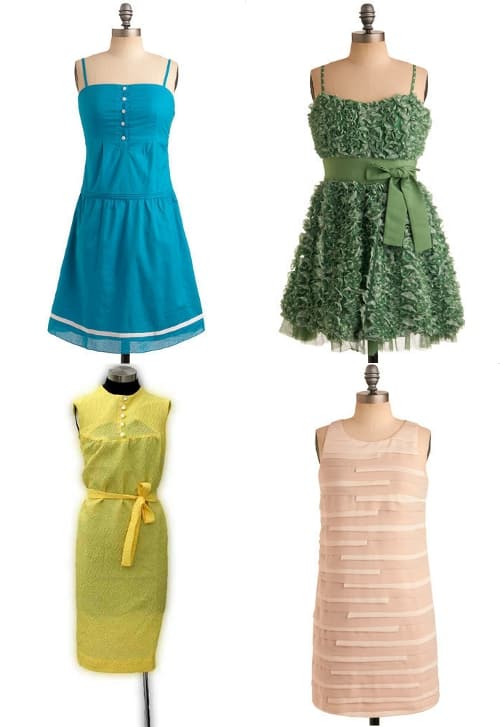
Happy Monday, everyone!!!
It gives me GREAT DELIGHT to start the week off in the best of ways — giving you a dash of vintage fashion inspiration & education with today’s post, plus almost too-good-to-be-true shop-happy enlightenment with a newly updated Shop Finds page.
According to our friend the weatherman, the temps in NYC are supposed to reach 80 degrees today! Last week I was still layering and stomping the streets in boots. But today, I’m opening my closet for a lovely vintage dress and style heightening heels.
The beautiful thing about life is that we never stop learning. I don’t care if you have your doctorate 10 times over … you are still a blank slate, open to new information, ideas and enlightening emotions.
Which is why I knew that despite having a deep pocket of useful vintage fashion information ready to dispose to you, it’s also my duty to keep room in my mind and heart to soak up helpful style facts and styles that will truly provide a service to YOU.
Today’s post does exactly just that: The thermometer says that spring is here, which means spring fashion is not just hanging in our closets … it’s on our bods and on our shopping lists! So when looking for a fresh spring frock, how do you differentiate between all the different names, from A-line to maxi; peplum to pinafore; sheath to shift; tent to wiggle and more?!
Keep reading after the jump to learn what the key style, construction and how-to-wear differences are in this season’s most talked about dresses, and to learn where you can buy the mentioned dress style online at ModCloth or Etsy right this very moment!
FYI Disclaimer: I chose to include a link to “vintage inspired” new pieces available to buy on ModCloth because thanks to feedback from you, I want to offer vintage fashion inspiration for all, and not just for that “special girl” who can fit into the piece I’m promoting on this site.
Thanks to ModCloth’s true passion for fashion and understanding of the female body and style consciousness, anyone can buy a vintage look-a-like in a size that suits their self-empowered style.
Is buying new better than buying vintage? In some cases, it’s a necessity! However, if you like a style and want it vintage, I pass my torch to you, vintage loving sister … because where there is a will, there is a WAY!
Also, thank you to everyone for entering the Gratefulness Giveaway last week! Winners will be announced on the site, Twitter and fan page tomorrow.
Happy dress learning and loving, fabulous ladies!
xx, SD
A-Line Dress
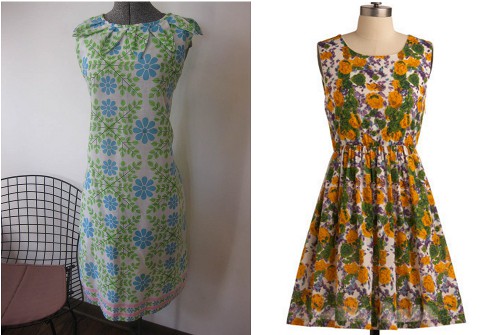
WHAT IS … A-LINE DRESS
STYLE NOTES: The a-line dress is called such because beginning at the waist, the dress flares outward slightly to give the hips more breathing room.
The A-line dress is usually form fitting at the chest to emphasize a cinched waist and A-line bottom. The flared dress bottom therefore appears as an “A” shape.
HOW TO WEAR: A-line skirts often end at the knee, so wear with colorful tights and heels for perfect posture and feminine flair.
WHO SHOULD WEAR: Ladies looking to provide breathing room for voluptuous hips and to create a natural waist.
PAST: Etsy, $26
PRESENT: Shop ModCloth, $99.99
Maxi Dress
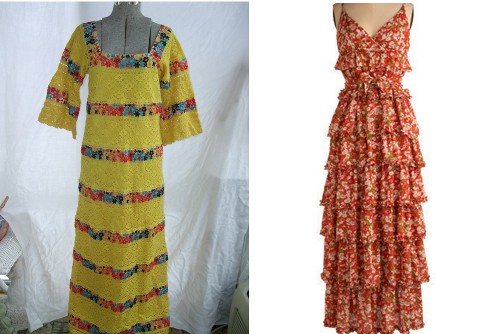
WHAT IS … TIERED MAXI DRESS
STYLE NOTES: A maxi dress is just a dress version of the season’s very trendy maxi skirt. The floor-length dress skirt is straight and slightly wide. It is not form fitting to the body.
A tiered maxi dress has a repeating pattern that appears as “cake tiers” or is constructed three dimensionally (see picture, right) repeating the same pattern to create that tier effect.
HOW TO WEAR: The tiered maxi dress is a more voluminous, full skirt than just the same-old cotton drawstring maxi. It should be worn on semi-warm days and always with flats, light thongs or gladiator sandals recommended.
If you need to wear an extra layer for evening, keep lengths similar with a light cotton sweater jacket that graces the bottom of your back.
WHO SHOULD WEAR: The style Gods have always said that lengthier ladies (read: taller) look better in maxi dresses. I’d say that yes, a 5’6″ or taller chica’s frame will suit a maxi dress more than a lady who is shorter.
But that doesn’t mean you have to be a glamazon to rock the style. Shorter ladies, avoid the vintage style shown here (left) because there is absolutely no waist.
This maxi dress has wide sleeves that cover all the skin, which is too much fabric and will overwhelm a smaller frame. Petite ladies should opt for maxi dresses with halter necks and cinched waists and with a creative neckline, like a scoop, bias or v-neck cut.
PAST: Etsy, $88, as curated on the Sammy Davis Vintage Shop Finds page
PRESENT: Shop ModCloth, $99.99
Peplum Dress
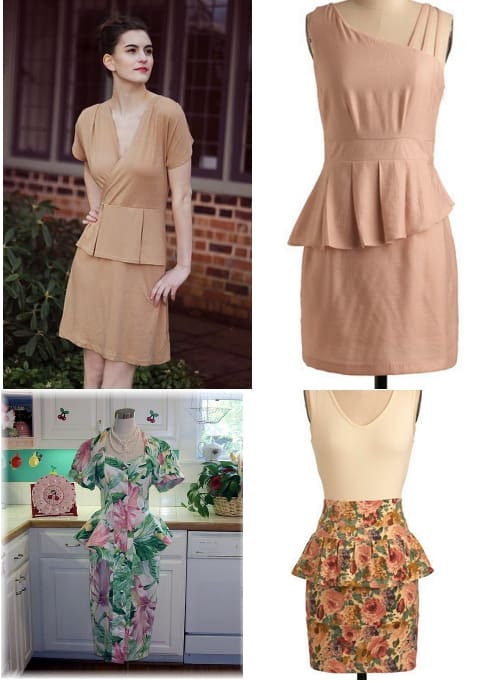
WHAT IS … PEPLUM DRESS
STYLE NOTES: The peplum dress has a double-layered skirt — the “peplum” itself is an overskirt of extra fabric to the skirt itself. There are two kinds of peplum overskirts: “fitted” (see left image, above) and “flared” (see left image, below).
Peplums were first popular on ladies’ fitted suit jackets in the 19th century. Peplums wouldn’t make a return until the ’40s, when they were popular not only on suit jackets but skirts and dresses, too.
HOW TO WEAR: Wearing the peplum dress in a modern way is a step down from the cocktail dress. The overskirt announces “I am a lady!” as if you were attending a special event where dress between the sexes is expected to be differentiated (think suits for guys, dresses for girls).
So, when wearing a peplum dress in a day situation, it’s important to note just how fancy you look so that you can accessorize appropriately. A cropped white cardigan would downplay the vintage dress (below, left) and a fitted black suit jacket would pair well with the modern version from Modcloth (below, right).
Last note: Always wear a peplum dress with heels. Because the style is a step below cocktail, you want to put your best foot forward!
WHO SHOULD WEAR: The peplum dress is like an hourglass figure whisperer — without having to do that whole “empire waist thing” over and over again!
If the peplum starts higher at the waist and covers the stomach slightly while still allowing the skirt to grace the hips, you’ve got yourself the perfect hourglass-flattering dress. A great example is the vintage style, shown left.
Narrow hip ladies, rejoice! The peplum dress can magically make hips appear on your body! Look for a peplum dress (see modern day example from ModCloth, below right) that covers your hips and not your stomach. That added overskirt layer adds volume to make it appear as if you are more voluptuous.
PAST (above left): Etsy, $75
PAST (below left): Etsy, $32
PRESENT (above right): Shop ModCloth, $99.99
PRESENT (below right): Shop ModCloth, $53.99
Pinafore Dress
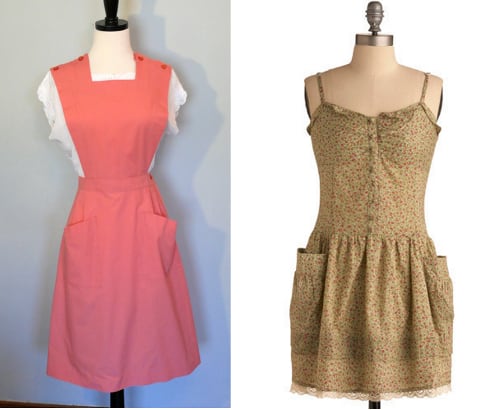
WHAT IS … PINAFORE DRESS
STYLE NOTES: The image that comes almost immediately to mind when thinking about the pinafore is that of Alice from Alice in Wonderland. Remember her white apron over the blue dress?
The white apron is actually called a pinafore apron, which is simply a sleeveless garment worn over dresses to protect them against soiling. The pinafore dress became popular in the 1870s as a style for children.
Like we see with Alice, the pinafore dress had a separate apron that was tied in the back, and which was a different color than the dress base itself.
Today’s version of the pinafore dress has similar elements but is all-around an updated version. Pinafore dresses were introduced as an everyday style for women all ages (and not just those who were cleaning!) in the ’40s. It was adopted again as a “country/peasant” look in the ’70s and ’80s.
HOW TO WEAR: Keeping in mind the current trends, the pinafore dress is a day dress worn best at picnics, outdoor festivals and BBQs or when doing anything that screams “outdoors,” “sunshine,” and “country.”
WHO SHOULD WEAR: Because the pinafore dress carries childish, almost impish connotations, it’s important to keep in mind how you want to portray yourself. If you are looking to dress down the age of your style, the pinafore dress is for you.
However, pinafore dresses also have a very pin-up girl quality to them when styled that way. Like a lot of “child” pieces in fashion, it can be stylishly sensualized to the opposite end of the spectrum.
If have cherub features and a very American girl look, the pinafore dress will probably suit your personality well. If you are an urban girl on-the-go, hopping from subway to cab and back down underground … the pinafore dress could make you stick out like a sore thumb, or at least like a burnt hot dog on a summer day’s grill.
PAST: Etsy, $32
PRESENT: Shop ModCloth, $44.99
Sheath Dress
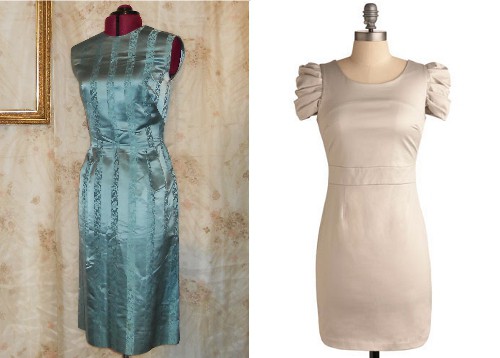
WHAT IS … SHEATH DRESS
STYLE NOTES: The sheath dress is distinctly different from the shift dress — but is way-too-often interchangeably used.
The sheath dress is designed to hug the body at the chest, waist and hips. It is almost formed to fit the skin, and often sleeveless and with a high neck to offset the piece’s body hugging qualities.
Think of the modern day bondage dress: That is an updated version of it’s close cousin, the sheath dress.
HOW TO WEAR: The sheath dress is for evening activities only, especially those that involve glamorous night out or a fabulous date.
WHO SHOULD WEAR: The key to wearing a sheath dress is finding the one that fits your body’s proportions right. Any figure can wear a sheath dress … if the dress only fits. Oh-too-often ladies try to fit into something a size or two too small, and woefully proclaim that “they just can’t rock the style.”
Know that the sheath dress is designed to accentuate a girl’s beautiful body. Weather you have a boy frame or the frame of Dita Von Teese, you can wear a sheath dress if the size is right.
PAST: Etsy, $68
PRESENT: Shop ModCloth, $57.99
Shift Dress
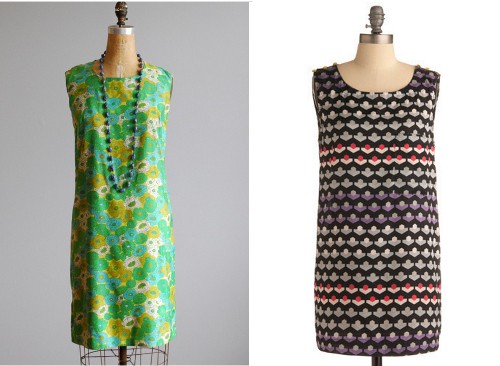
WHAT IS … SHIFT DRESS
STYLE NOTES: Unlike the body-hugging sheath dress, the shift dress does just the opposite. It’s a relaxed fit that’s loose all the way through, allowing breathing room from the neck to the chest to the waist and along the legs.
Shift dresses, like sheath dresses, are knee-length nearly 100 percent of the time. Their shared attributes in length could be part of the reason for confusion.
You’ll know that you’re wearing a shift dress because it should flare out all along the body, so much so that you may want to take a skinny belt to create a waist and fitted feel.
While sheath dresses can have short or puff sleeves, shift dresses are almost always sleeveless.
HOW TO WEAR: The shift dress is perfect for just about anything and anywhere. I imagine the most glamorous of women wearing a vintage version to the grocery store with pearls, or funking up with gold bling and strappy heels for night.
Try a shift dress with leggings, boots and a leather jacket for a cosmopolitan feel, or throw one on with a sun hat and flats to gallivant around the boardwalk this summer.
WHO SHOULD WEAR: The key to wearing a shift dress for you is finding one with the appropriate length for your frame. Shift dresses should hit the knee or right above. Anything shorter and you’re drifting into babydoll mini territory.
When buying online, note how long the dress is. Measure your neck to your knee to see how the length compares. Ask the seller how tall the model or mannequin is, to get an idea of how the dress sits on their body.
PAST: Etsy, $68 as curated on the Sammy Davis Vintage Shop Finds page
PRESENT: Shop ModCloth, $82.99
Shirtwaist Dress
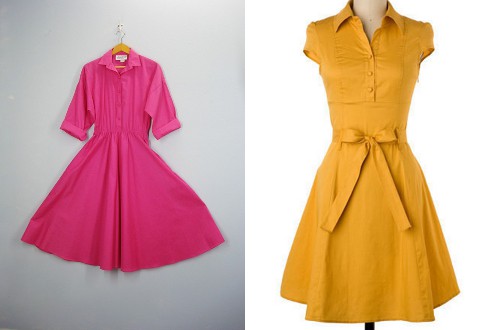
WHAT IS … SHIRTWAIST DRESS
STYLE NOTES: The shirtwaist dress gained popularity in the ’30s and ’40s, designed to incorporate the popular button down shirt of a man into a women’s dress. It was a popular trend for wives with families looking for the function of a men’s shirt that still had feminine flair.
The shirtwaist dress has been revived and revitalized numerous times in style history, taking on tunic form and worn with leggings and boots, or remaining straight and narrow as a shirt dress “shift” dress. It’s now considered as classic as the wrap dress.
HOW TO WEAR: While the shirtwaist dress is a functionally stylish addition to anyone’s wardrobe, it can leave you looking more “housewife” than “hot.”
Modernize by opting for solid brights (like bright pink or canary yellow) over gingham checks or florals. For spring, avoid the classic plaid shirtdress, which even when made from light cotton and not flannel, is a fall/winter appropriate pattern.
Wear a complementary color tank underneath, open the shirt buttons and allow for a pop of color below.
Funk it up with cowboy boots and bare legs. If the waist is missing an accessory (like the modern version, right) add a super-wide (2 inches plus) contrasting belt to further emphasize your waist. Try bright green with bright pink or darker colors like royal purple or navy with canary yellow.
WHO SHOULD WEAR: The girl who wants to throw on a dress and walk out the door, fun & fancy free. Like it’s original intention, the shirtwaist dress with an A-line skirt is a body-flattering style on anyone that is functional for everyday while still fun enough to call “girlie.”
Avoiding prints,checks & plaid maintains solid style sense — opt for the season’s bright trend instead to dress for a modern, marvelous you.
PAST: Etsy, $24
PRESENT: Shop ModCloth, $44.99
Tent Dress
STYLE NOTES: The tent dress is like wearing A-line which covers your entire body. Instead of flaring out at the waist, the dress flairs beginning below the chest. The tent dress can consist of a few well-placed pleats or multiple pleats for a classic evening style (see modern version, right).
The A-line shape is technically called a “pyramid” flare. The style was introduced by designer Pierre Cardin for his spring ’66 collection.
HOW TO WEAR: Depending on the design and placement of pleats, the tent dress can work for evening as more of a “babydoll dress” look, or for day when styled with patterns, like large florals seen in the vintage version (left).
Tent dresses for day are often designed with larger patterns — it’s uncommon to see “ditsy” (small print florals or polka dots) here. For evening, the tent dress is sans design, sticking to neutral colors that can be vamped with the right bling accessory.
WHO SHOULD WEAR: Tent dresses take on a more “babydoll” approach to exposing the skin (read: they hit above the knee). Ladies anxious to show off their toned calves should look to the tent dress to draw attention to their best asset.
If you are a larger busted lady, the tent dress can look like a maternity dress because your chest will literally push the material away from your body. If you are larger chest and want to wear a tent dress, make sure you belt it with a skinny belt to create a waist.
Tent dresses look best with close-toed or peep toe pumps in solid colors and narrow stiletto heels. Avoid platforms, flats and chunky heels — you’ll either look too retro or like you’re dressing down your age.
PAST: Etsy, $22
PRESENT: Shop ModCloth, $44.99
Wiggle Dress
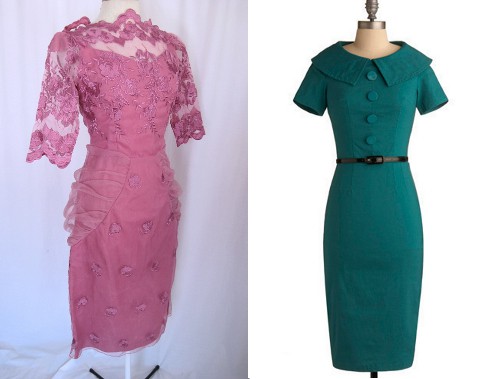
WHAT IS … WIGGLE DRESS
STYLE NOTES: The “wiggle” dress is a true vintage piece, especially because the term “wiggle” is not part of the common style vernacular of today.
It’s a laymen’s term for a dress which causes a woman to “wiggle” when she walks, because the skirt is fitted from the waist down to hug her legs so tight that she must walk delicately and with small steps.
For more information on the wiggle dress, check out an article by my friends over at the Vintage Bullentin.
Many wiggle dresses resemble “secretary dresses” of the ’50’s and ’60s — appropriate for that time period, because secretaries spent most of their day’s sitting down and therefore did not need to move or “wiggle about the office.” However, when they did move, the wiggle dress created a beautiful silhouette that (ahem) many bossmen of the day probably enjoyed admiring from their desks.
HOW TO WEAR: Some wiggle dresses (see vintage, left) are styled for evening, but most often you’re going to find that secretary-esque style that carries a professional vibe with a button-up front, solid color and crisp design.
Wiggle dresses are perfect as they are and don’t need much more than black or nude tights (lean away from patterned, unless you want to look more pin-up girl) and pointy-toed pumps.
Round pumps are a bit more matronly and will take away from the “wiggle” wow factor of the dresses’ stylish sex appeal.
WHO SHOULD WEAR: Ladies with a bootylicious backside will either embrace the wiggle dress or shake their heads in distaste. Want to show off your goods? This the dress to do that. But beware: that boss man (and construction men … police men … etc.) are going to take notice!
Ladies with balanced proportions will enjoy the wiggle dress, too, especially because it’s “midi” length (hits past the knee at about mid calf) will elongate anyone’s frame without feeling like you’re wearing a floor sweeping ball gown.
PAST: Etsy, $125
PRESENT: Shop ModCloth, $101.99
MORE VINTAGE DRESSES
TREND: Ways to Wear This Season’s Drop-Waist Dress Trend
THE GREAT GATSBY: How to Wear ’20s-Inspired Fashion for Spring

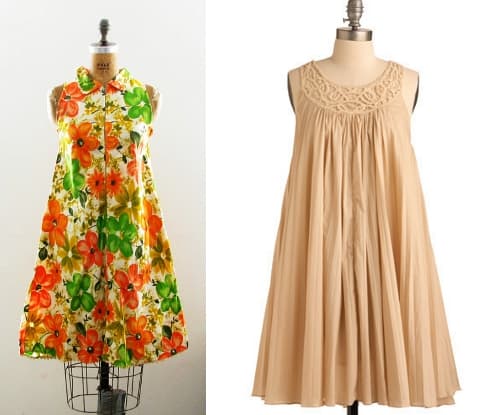
I absolutely love the shirtwaist style! I’ve got a small bust, narrow waist and wide hips, and this style complements my shape perfectly. It’s modest, feminine, and so girly!
FYI, the link to the “Past” Tent dress is actually:
http://www.etsy.com/listing/51452547/sale-was-28-vintage-1960s-tangerine-and
Great post!
I love your website!!! I could spend days here! I’m so glad I found you!
Susan
http://www.etsy.com/shop/SuzisCornerBoutique?ref=si_shop